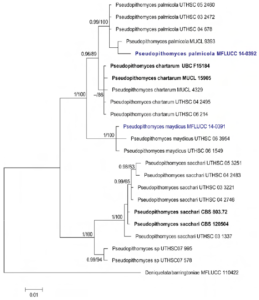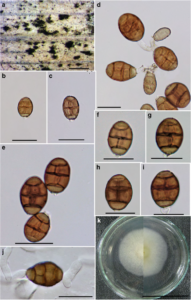Pseudopithomyces palmicola J.F. Li, Ariyawansa & K.D. Hyde, sp.
Index Fungorum number: IF551394; Facesoffungi number: FoF00939; Fig. 2
Etymology – The name palmicola, refers to the common host name and Latin cola meaning loving.
Holotype – MFLU 15-1474
Saprobic on leaves of Acoelorrhaphe wrightii (Griseb. & H. Wendl . ) H. Wendl. ex Becc. Sexual morph: Undetermined. Asexual morph: Colonies effuse, dark brown to black. Mycelium superficial or partly immersed on the substrate, composed of septate, branched, smooth, thin-walled, pale to grey hyphae. Conidiophores 3.6 –6 × 3.2 – 3.5 μm (x̄ = 5.5 × 3.3 μm, n = 100), micronematous, mononemous, closely packed, hyaline, thin-walled, aseptate, smooth, branched, flexuous. Conidiogenous cells 3.5 – 5.5 × 2.5 – 3.5 μm (x̄ = 4.5 × 3.3 μm, n = 100), monoblastic, phialidic, integrated, terminal, determinate, hyaline, globose or subglobose. Conidia 21.5 – 30.5 × 10 – 16.5 μm (x̄ = 27.9 ×1 4.2 μm, n=100), acrogenous, muriform, subglobose, 6–8-septate, verruculose to echinulate, amygdaliform or ovoid, thin-walled, light brown to brown.
Cultural characteristics – Conidia germinating on PDA within 14 h and germ tubes produced from end cells. Colonies growing on PDA, cottony, grey to brown, reaching 5 mm in 20 days at 25 °C, mycelium superficial, effuse, radially striate, with regular edge, hyphae pale to yellowwhite; asexual spores and sexual spores were not formed within 60 days.
Material examined – THAILAND, Chiang Rai Provice, Mae Fah Luang, on leaves of Acoelorrhaphe wrightii (Griseb. & H. Wendl.) H. Wendl. ex Becc. (Arecaceae), 26 January 2014, J.F. Li, H-4l (MFLU 15-1474, holotype), ex-type living culture, MFLUCC 14-0392, KUMCC 15-0100.
Notes – Phylogenetic analysis based on ITS and LSU sequence data showed that Pseudopithomyces palmicola is closely related to, but forms a distinct lineage from the Pse. chartarum clade (Fig. 1). Pseudopithomyces palmicola is similar to P. chartarum in having three constricted transverse septa and 1 – 2 longitudinal septa in the central cells. Pseudopithomyces palmicola differs from Pse. chartarum in having thick and hyaline conidiophores and mostly globose, pale brown conidia with slightly constricted septa, while Pse. palmicola has thin and heavily pigmented conidiophores with dark brown conidia which are comparatively more constricted at the septa (da Cunha 2014). Furthermore P. palmicola forms pale to yellow white colonies on PDA, while Pse. chartarum forms white to dark grey colonies on PDA (Supplementary Table 1).

Fig. 1 Phylogram generated from Bayesian analysis based on ITS and LSU sequence data. Bayesian posterior probabilities (PP) greater than 0.90 are indicated above or below the nodes. The ex-type and reference strains are in bold, the new isolates are in blue. The tree is rooted with Deniquelata barringtoniae (MFLUCC 11-0422).

Fig. 2 Pseudopithomyces palmicola (holotype) a Colonies on palm leaves b, c Immature conidia d Conidiophores bearing conidia e – i Conidia j Germinating conidium k Upper and lower view of colony. Scale bars: a = 500 μm, b – j = 20 μm, k = 5 cm.
